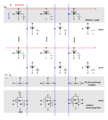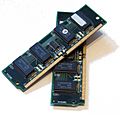Dynamic random-access memory facts for kids
Dynamic random access memory, often called DRAM, is the most common type of RAM used in computers. Think of RAM as your computer's short-term memory, where it keeps information it needs right now.
DRAM is called "dynamic" because it needs constant attention to remember things. If it's not refreshed all the time, it will forget the data it's holding. Because DRAM loses its data when the power is turned off, it's known as "volatile" memory. This word comes from a Latin word meaning "flying" or "fleeting."
Refreshing DRAM means the computer quickly reads the data from the DRAM and then immediately writes it back again. This happens many times every second.
DRAM is built from millions of tiny parts called capacitors. Each capacitor is like a tiny bucket that can hold a small electric charge, representing a piece of data (like a 1 or a 0). Next to each capacitor is a transistor, which acts like a gate, letting energy in and out. These tiny capacitors slowly lose their charge. If the DRAM isn't refreshed often enough, a capacitor might lose too much energy, causing a 1 to accidentally become a 0, and the data gets lost or mixed up.
DRAM vs. SRAM: What's the Difference?
DRAM is often compared to another type of memory called SRAM, which stands for Static RAM. Both are types of RAM, but they work a bit differently.
- SRAM can hold data as long as it has power, without needing to be refreshed constantly.
- SRAM can also be faster than DRAM.
- However, SRAM is much more expensive to make than DRAM.
- Also, SRAM uses more electricity and can get hotter faster than DRAM.
Both DRAM and SRAM lose all their data when the computer is turned off. This is different from non-volatile random-access memory, which can remember things even without power.
Images for kids
-
A close-up picture of a chip from a Micron Technology MT4C1024 DRAM, made in 1994. It could store 1 megabit of data, which is 128 kilobytes.
-
Two 32 MB EDO DRAM memory sticks.
See also
 In Spanish: DRAM para niños
In Spanish: DRAM para niños












